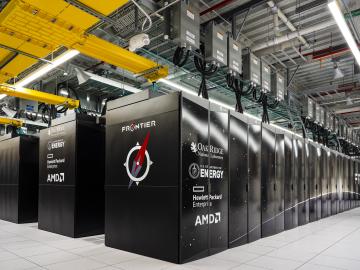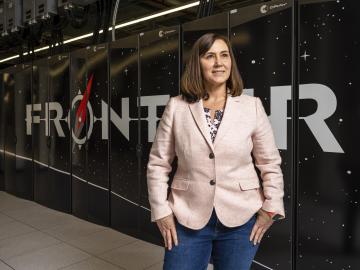
Filter News
Area of Research
- (-) Fusion and Fission (8)
- (-) Materials (155)
- (-) National Security (13)
- (-) Supercomputing (86)
- Advanced Manufacturing (10)
- Biology and Environment (34)
- Computational Engineering (1)
- Computer Science (5)
- Electricity and Smart Grid (1)
- Energy Science (125)
- Functional Materials for Energy (2)
- Fusion Energy (4)
- Isotope Development and Production (1)
- Isotopes (7)
- Materials Characterization (2)
- Materials for Computing (23)
- Materials Under Extremes (1)
- Neutron Science (42)
- Nuclear Science and Technology (7)
- Quantum information Science (2)
- Transportation Systems (2)
News Topics
- (-) Big Data (25)
- (-) Exascale Computing (27)
- (-) Frontier (33)
- (-) Materials (81)
- (-) Materials Science (84)
- (-) Microscopy (29)
- (-) Space Exploration (5)
- (-) Transportation (23)
- 3-D Printing/Advanced Manufacturing (30)
- Advanced Reactors (12)
- Artificial Intelligence (48)
- Bioenergy (20)
- Biology (18)
- Biomedical (23)
- Biotechnology (3)
- Buildings (8)
- Chemical Sciences (34)
- Clean Water (3)
- Composites (9)
- Computer Science (108)
- Coronavirus (19)
- Critical Materials (15)
- Cybersecurity (23)
- Education (1)
- Energy Storage (38)
- Environment (40)
- Fossil Energy (1)
- Fusion (29)
- Grid (16)
- High-Performance Computing (48)
- Irradiation (1)
- Isotopes (15)
- ITER (6)
- Machine Learning (24)
- Mathematics (2)
- Molten Salt (3)
- Nanotechnology (42)
- National Security (36)
- Neutron Science (44)
- Nuclear Energy (50)
- Partnerships (17)
- Physics (35)
- Polymers (18)
- Quantum Computing (21)
- Quantum Science (34)
- Security (15)
- Simulation (19)
- Software (1)
- Summit (43)
Media Contacts

An advance in a topological insulator material — whose interior behaves like an electrical insulator but whose surface behaves like a conductor — could revolutionize the fields of next-generation electronics and quantum computing, according to scientists at ORNL.

To support the development of a revolutionary new open fan engine architecture for the future of flight, GE Aerospace has run simulations using the world’s fastest supercomputer capable of crunching data in excess of exascale speed, or more than a quintillion calculations per second.

Innovations in artificial intelligence are rapidly shaping our world, from virtual assistants and chatbots to self-driving cars and automated manufacturing.

Scientists at ORNL have invented a coating that could dramatically reduce friction in common load-bearing systems with moving parts, from vehicle drive trains to wind

Stan David, retired scientist and Corporate Fellow Emeritus at the Department of Energy’s Oak Ridge National Laboratory, was awarded the Joining and Welding Science Award from the Joining and Welding Research Institute at Osaka University, Japan.

ORNL scientists found that a small tweak created big performance improvements in a type of solid-state battery, a technology considered vital to broader electric vehicle adoption.

Rigoberto Advincula, a renowned scientist at ORNL and professor of Chemical and Biomolecular Engineering at the University of Tennessee, has won the Netzsch North American Thermal Analysis Society Fellows Award for 2023.

Lawrence Livermore National Laboratory’s Lori Diachin will take over as director of the Department of Energy’s Exascale Computing Project on June 1, guiding the successful, multi-institutional high-performance computing effort through its final stages.

ORNL’s Debangshu Mukherjee has been named an npj Computational Materials “Reviewer of the Year.”

At the National Center for Computational Sciences, Ashley Barker enjoys one of the least complicated–sounding job titles at ORNL: section head of operations. But within that seemingly ordinary designation lurks a multitude of demanding roles as she oversees the complete user experience for NCCS computer systems.


